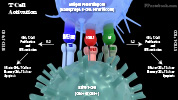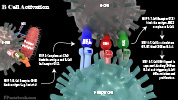II. Definitions
- Antigen
- Molecules recognized by antibodies, or by T Cells (as peptides presented via MHC complex on host cells)
- Possible Antigens include Proteins, Nucleic Acids, lipids, complex Carbohydrates
- Antigens must be macromolecules, large enough to generate an immune response (Immunogens)
- Antigens have one or more Epitopes to which immune agents (e.g. antibodies) bind
- Hapten
- Antigen that is too small on its own to generate an immune response
- When Haptens are attached to macromolecules (immunogens), that may act as Epitopes for immune binding
- Immunogen
- Antigen that is large enough to generate an immune response
- Epitopes (Determinants)
- Antigen regions to which immune agents (e.g. antibodies) bind
- Antigen Processing
- Conversion to peptides of exogenous Antigens (endocytic path) and endogenous Antigens (cytosolic path)
- Peptide form is required for T-Cell recognition
III. Images
IV. Type: Cytosolic Pathway for Endogenous Antigens (MHC Class I Complex)
- Indications
- Endogenous Antigens (e.g. Intracellular Bacteria, intracellular Parasites, viruses)
- Antigen Processing starts within the cell cytosol
- Pathway
- Intracellular Antigens within the cell cytosol are processed by proteolytic enzymes within proteasome
- Processing results in converting Antigens to peptides
- Peptides are moved to endoplasmic reticulum where they are bound to MHC Class I molecules
- Antigen Peptide-MHC Class I Complex is moved to cell surface via golgi complex
- Intracellular Antigens within the cell cytosol are processed by proteolytic enzymes within proteasome
- Antigen Presenting Cells (APC or Host Cells) displaying MHC Class I Complex
- All nucleated host cells (unlike MHC Class II of the Endocytic Pathway)
- Cells with Receptors Recognizing MHC Class I Complex
- CD8+ T-Cells (Cytotoxic T-Cells)
V. Type: Endocytic Pathway for Exogenous Antigens (MHC Class II Complex)
- Indications
- Exogenous Antigens
- Pathway
- Exogenous Antigens are engulfed by cells via Phagocytosis (endocytosis) as Phagosomes (endosomes)
- Cell membrane invaginates around the Antigens, surrounding them in a Vesicle
- Phagosomes fuse with Lysosomes (forming phagolysosomes)
- Proteolytic enzymes within the Lysosome breakdown or process the Antigen into peptides
- Antigenic peptides are bound to MHC Class IIMolecules while still inside the phagolysosome
- Antigen Peptide-MHC Class II Complex is moved to cell surface via secretory Vesicles
- Exogenous Antigens are engulfed by cells via Phagocytosis (endocytosis) as Phagosomes (endosomes)
- Antigen Presenting Cells (APC or Host Cells) displaying MHC Class II Complex
- Langerhans Cells and Dendritic Cells
- Macrophages
- B-Cell (B-Lymphocyte)
- Cells with Receptors Recognizing MHC Class II Complex
- CD4+ T-Cells (T-Helper Cells)
VI. References
- Mahmoudi (2014) Immunology Made Ridiculously Simple, MedMaster, Miami, FL
- Guyton and Hall (2006) Medical Physiology, p. 419-50


